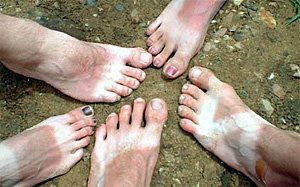 When I was at the University of Arizona there were various news stories about a so-called "Barbie" drug that stimulated tanning, libido, and weight loss... great right? Perhaps. There were actually two drugs developed at the University of Arizona called Melanotan I and II which are analogs of the naturally occurring hormone called alpha-MSH, or melanocyte stimulating hormone. These drugs and the hormone stimulate (among other things) increased melanin production by melanocytes in the skin, thus leading to increased pigmentation or tanning. When your skin cells or keratinocytes are bombarded with UV light, they release alpha-MSH or closely related peptides that then trigger natural tanning as a protection to UV exposure and damage (see link).
When I was at the University of Arizona there were various news stories about a so-called "Barbie" drug that stimulated tanning, libido, and weight loss... great right? Perhaps. There were actually two drugs developed at the University of Arizona called Melanotan I and II which are analogs of the naturally occurring hormone called alpha-MSH, or melanocyte stimulating hormone. These drugs and the hormone stimulate (among other things) increased melanin production by melanocytes in the skin, thus leading to increased pigmentation or tanning. When your skin cells or keratinocytes are bombarded with UV light, they release alpha-MSH or closely related peptides that then trigger natural tanning as a protection to UV exposure and damage (see link).The possibility of an injectable or drug-induced tan is quickly becoming a reality in Europe, Australia, and now even the United States. Clinuvel Pharmaceuticals is performing late stage clinical trials with afamelanotide (or melanotan I) as a photoprotective drug that induces skin pigmentation... tanning. Afamelanotide is being promoted as a photoprotective product to treat several skin disorders that cause photosensitivity, while the drug's use in cosmetic tanning is being downplayed by the company. However, once a drug is eventually approved by agencies like the FDA then doctors are free to prescribe them for "off-label" use which would seemingly include cosmetic tanning. You can only imagine how popular that would be, right? Some concerns exist that melanotan could possibly cause melanocytes to become cancerous (e.g., melanoma). However, safety concerns like these would obviously need to be addressed before the drug is approved for use in people. Note: the potential use of melanotan I and II for sexual dysfunction seems to have been halted due to safety issues and of course the availability of effective drugs like Viagra and Cialis. Melanotan uses in obesity therapy and weight loss seem to be in very early stages at best. See Palatin Technologies for these uses of melanotan.
Read a recent Wire blog entry about melanotan and Clinuvel here at this link.
~ ~ BIO26 ~ ~
